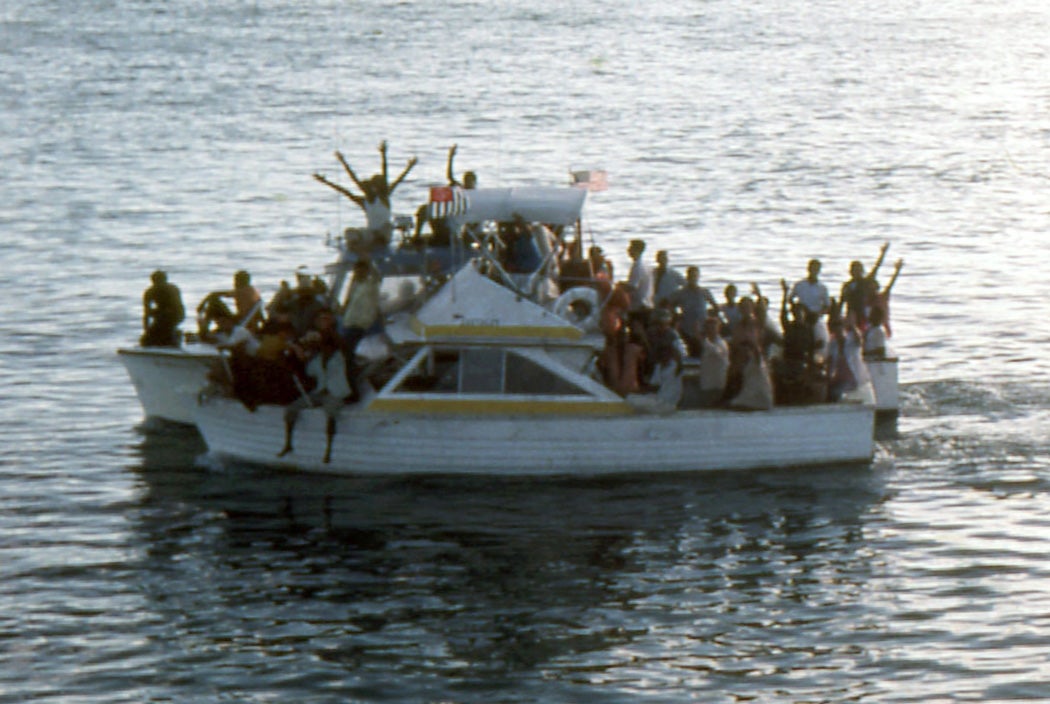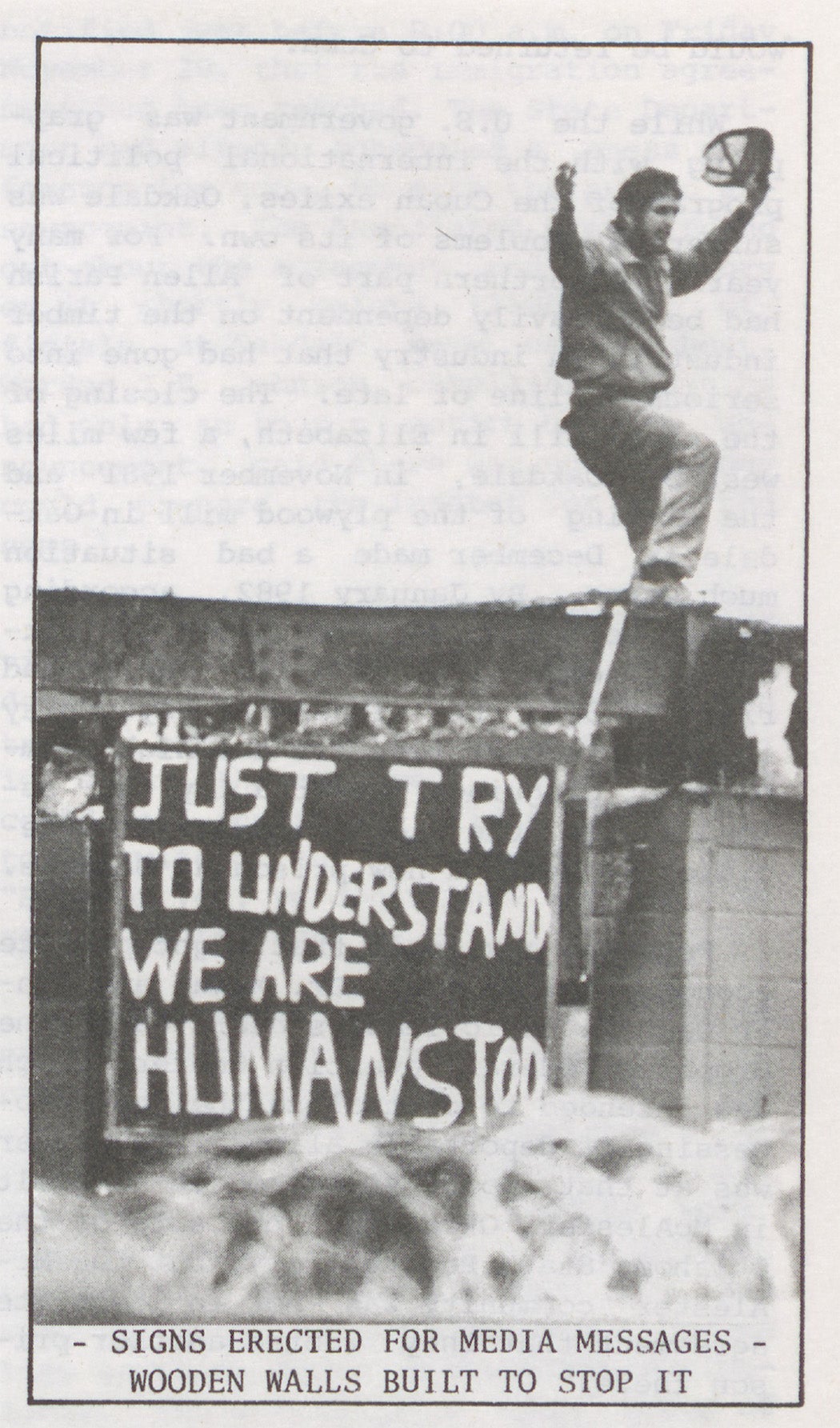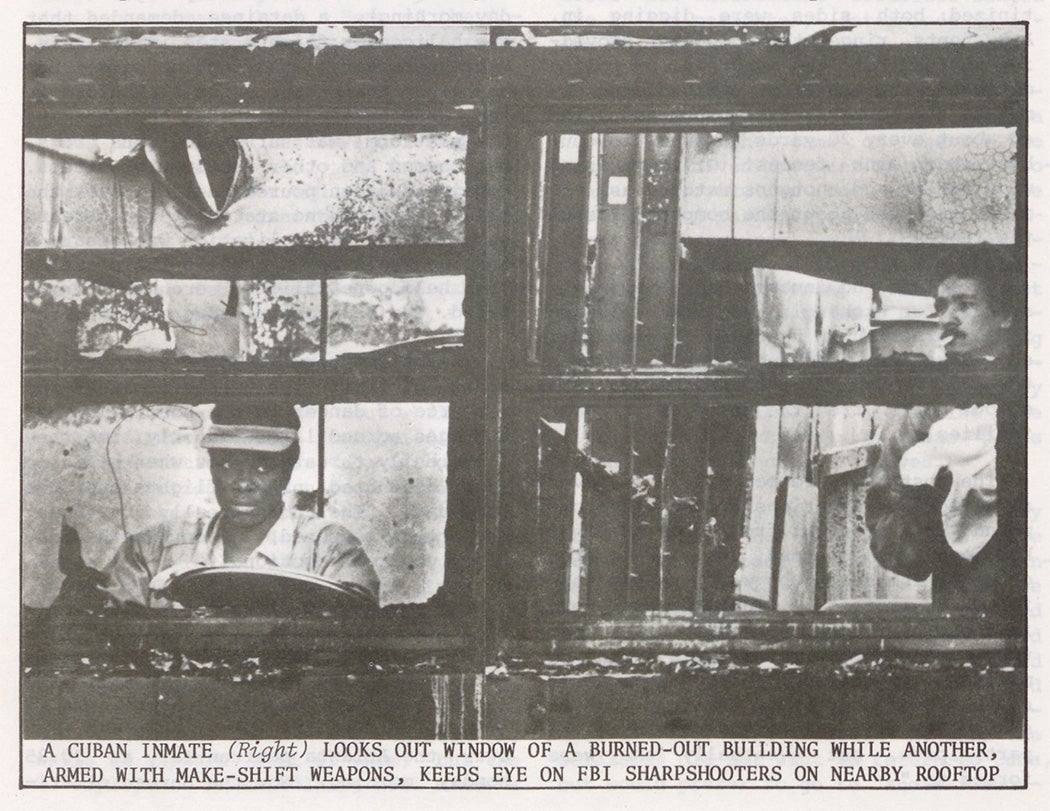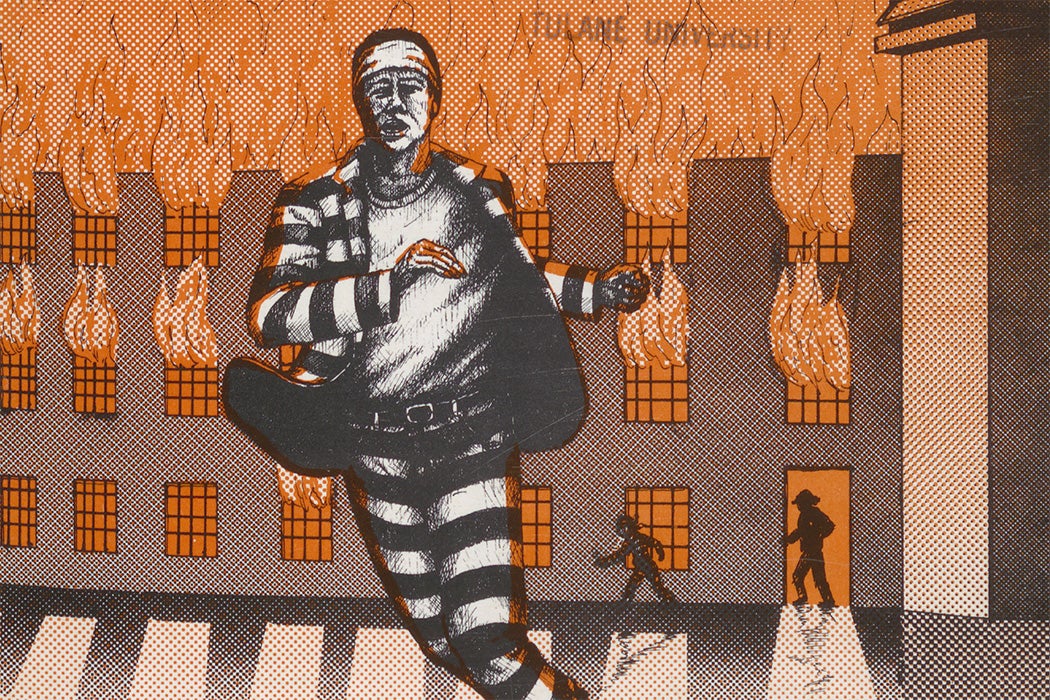The Cold War is rarely thought of as having had a fiery battlefront on US soil, but it directly led to the partial destruction of federal prisons in Louisiana and Georgia. Overshadowed by bloodier prison uprisings that had more lasting impacts on the American prison system, the Oakdale prison riot is the rare intersection of American mass incarceration and its fraught international diplomacy. On November 21, 1987, a geopolitical maelstrom culminated in a prison uprising.
Cuban nationals were being held in American federal prisons indefinitely, unable to be released into the United States and unable to be deported back to their country of citizenship. They were often denied court hearings. On November 20, news of their imminent deportation back to Fidel Castro’s Cuba served as the metaphorical match that lit the spark of frustration. The Oakdale Federal Detention Center in Oakdale, Louisiana, went up in flames, literally. The one in Atlanta followed close on its heels.
What is now known as the Oakdale prison riot is hardly a part of America’s collective consciousness, despite the event’s gravity at the time. Prisoners, nearly stateless, took control of multiple federal buildings, not only the prison in Oakdale but simultaneously seizing control of the even more infamous federal prison in Atlanta. Their chief demand has rarely been seen before or since: to not be released, if being released meant being returned to Cuba.
Background
To understand the Oakdale prison riot, one must first understand the geopolitical context that produced it. By 1979, the Cold War was reaching levels of tension not seen since the Cuban Missile Crisis. In 1980, Castro’s Cuba allowed over 125,000 Cuban nationals to immigrate to the United States from the Port of Mariel, earning the operation the name the Mariel boatlift and the emigres the name Marielitos. They landed in Key West, Florida and were processed by immigration authorities.

It is estimated that over 16,000 of the Marielitos were considered “undesirables” by the Cuban regime, having criminal records. That number was inflated by the fact most had committed minor offenses—both homosexuality and being transgender were considered criminal offenses in Cuba—or had merely dissented against the regime. A much smaller proportion, about 2,700, had been convicted of dangerous crimes.
Even though most were received by President Jimmy Carter’s administration as political refugees, by 1987 around 7,600 were in confinement in the US. Of those, 3,806 were detained as excludable aliens, many of whom had served sentences for crimes committed on US soil. Exercising what little political power the small island nation could while staring down the world’s most powerful superpower, Cuba simply refused to accept any deportees. The US was foisted into a challenging position as the number of Cubans designated for deportation mounted, leaving them stranded in interminable detention.
Weekly Newsletter
Around 2,500 of the incarcerated Cubans were detained in the two facilities in Oakdale and Atlanta, awaiting the results of reviews that would either clear them for immigration parole or keep them imprisoned until they could be returned to Cuba.
The indefinite detention of many of these immigrants was constitutionally possible because the US appellate courts ruled they were “aliens” in 1984, and therefore devoid of constitutional rights.
In 1984, well into the indefinite detention of Cubans on US soil, the Cuban government agreed to accept the return of 2,746 Marielitos. Cuba accepted a mere 201 of them before terminating the agreement, which was intended to convey displeasure with American radio broadcasts into Cuba over Radio Martí.
Bureaucratic processes that are typically slow and often pained dragged on with little progress. International diplomacy and the American prison system intersected in ways that had very real consequences on thousands of human beings. Human beings that were not American citizens but were nevertheless on US soil.
The Oakdale Riot
The Oakdale Federal Detention Center was operated jointly by the Federal Bureau of Prisons and the Immigration and Naturalization Service. The facility opened its doors in March of 1986 and by October of that same year Oakdale’s would be designated a “Cubans only” facility. They set “to increase the number of beds from 600 to about 900,” thus transforming the site from holding short term multinational detainees to a long term place for Cuban nationals suffering from indefinite detention.
The US Penitentiary in Atlanta had even more dire circumstances. Being one of the toughest maximum security facilities in the country, the penitentiary was slated to be shuttered but stayed open to house Cuban prisoners, even though it had been deemed overcrowded by a Congressional subcommittee. With both prisons overcrowded, and diplomatic tensions at new heights, the ambiance was ripe for trouble.
The strife erupted into a full-scale rebellion on November 21, 1987, a day after the US and Cuban governments signed an agreement that would force many of the detainees to be involuntarily repatriated to Cuba. Correctional officers lament that the Bureau of Prisons was given too short of notice of this seismic shift in tact, one that angered the detainees whose fate it was deciding.

At Oakdale, the Cuban detainees took control of the facility. Two days later, the same happened in Atlanta. The progression of events reads standard for a prison uprising, if such a thing can be considered standard at all. “At 6:50 the attack came, 200 Cubans charging the front gate, waving clubs and crude homemade weapons”. In less than four hours, 10 of the 14 buildings were on fire, and 28 prison employees were taken hostage. As the takeover stretched into the week, the Cubans nominated four detainees to represent them in negotiations with authorities. By Thursday, things moved forward to the point that they released one hostage as a sign of good faith.
During the whole Oakdale prison riot, the 28 hostages were, for the most part, physically unharmed. The notable exception was the attack on Manny Cedillos, a prison mental health counselor. Early Friday morning, six days into the takeover, Cedillos was brought to the front gates “bleeding profusely from stab wounds to the shoulders and head.” He had been attacked by a “mentally deranged inmate” according to the detainees, who sought medical attention for him immediately. The attacker was reprimanded by other detainees, who were enraged by the assault.

The detainees were savvy enough to not fully trust their negotiation partners. Early attempts by the government and its chosen mediators, mostly right-wing Cuban-Americans, to come to a signed resolution agreement were bumbled and broadly distrusted by the detainees. They made a sign that read “We want the Bishop” and displayed it prominently on the front gate. It worked. They secured Bishop Román of Miami, himself a Cuban exile, as their trusted negotiator.
On Sunday, November 29, Bishop Agustín A. Román of Miami, himself a Cuban exile, was finally driven up to the perimeter of the prison after having been flown in the day before, per the Cubans’ request. He informed the detainees at Oakdale that the Attorney General had agreed to a moratorium on deportations. He was able to successfully get the detainees to sign the agreement. They laid down their weapons, and the Bishop delivered mass to the detainees. The Oakdale uprising was over, the Cubans surrendered. The takeover at Atlanta lasted another week, but the Cuban detainees surrendered on December 4 after Bishop Román helped negotiate an agreement there, too. There was one reported fatality between both takeovers, a Cuban detainee José Peña Pérez in Atlanta.
Not Business As Usual
What really set these prison uprisings apart from any other in the history of the United States, before or since, were their demands. The detainees basically wanted to stay in the US. They didn’t want to return to Castro-led Cuba, even if that meant being bound within the bureaucracy of the American prison system, indignities and all. What does it say about the human condition when thousands of detainees riot to stay in the United States, even if it means staying in prison?
The uprising at Oakdale and Atlanta were some of the few Cold War consequences to be felt directly on American soil. Many Cold War conflicts were fought through proxy nations, often with fewer resources and fewer avenues for recourse. Stateside, Americans saw scant tangible examples of the effects of their foreign policy.
The Cold War stalemate between America and Cuba ended with American infrastructure destroyed, tens of millions in damages, and lives in danger on US soil, something seldom seen due to the mightiness of the US government’s reach. This is one instance that got out of hand within its own borders.
After garnering national attention, the uprisings ended with the basic demands of the detainees met: a moratorium on deportations and the right to parole hearings. “What the Cubans wanted, and what they finally got, was the government’s promise to take them seriously,” reported the The Angolite. It was no small feat, and less drastic means had failed to accomplish it.
A Few Lessons, Even More Questions
Both Oakdale and Atlanta were severely overcrowded when the uprisings began. The Oakdale prison held 1,039 inmates, 81% above its capacity. With 1,591 detainees, the prison in Atlanta was 47% above its capacity. Detainees outnumbered correctional officers and well outmatched them in both passion and frustration.
That the US Government failed to inform its own Bureau of Prisons, let alone the Cuban detainees, and the fact that they had signed a repatriation agreement with Cuba contributed to the clash. It was predictable, especially given the aforementioned overcrowdedness, that an abrupt announcement deciding the fate of the detainees could sow discord if not mayhem.
Beyond conversations around the Cold War itself, the uprisings sparked questions about basic rights: what happens when a constitution, the supposed cornerstone of law and justice in a land, fails to protect every human being within it? The Cuban prisoners had basically no rights under the Constitution, due to courts repeatedly upholding the “entry doctrine” that considered excludable aliens to still be in detention at the border, despite their physical presence in the country. The Reagan Administration had the policy of treating the detainees as a bloc of dangerous criminals, even though there was overwhelming evidence of the contrary.
A prompt hearing for the detainees or even basic procedural rights could have meant avoiding the uprisings. Cubans fled their home country en masse seeking freedom, only to end up indefinitely imprisoned in the land of liberty, to paraphrase Elliott Young, who wrote the book titled Forever Prisoners: How the United States Made the World’s Largest Immigrant Detention System.
Today, much of the coverage of the Oakdale riot focuses on prison conditions or the plight of the hostages, but rarely the plight of the Cubans themselves. Seldom mentioned is the ultimate fate of the Cuban detainees, who are still often framed as little more than “criminals.” Ultimately, many of the detainees were forcibly deported to Cuba, though some not until years later.
The deportation of Cubans remains contentious, 35 years later. Between October 2021 and September 2022, 220,000 Cubans were detained at the US-Mexico border, shattering the previous Cuban immigration record set by the Mariel boatlift. Though the Oakdale prison riot has been relegated to history, its geopolitical underpinnings are ongoing.
Support JSTOR Daily! Join our new membership program on Patreon today.







